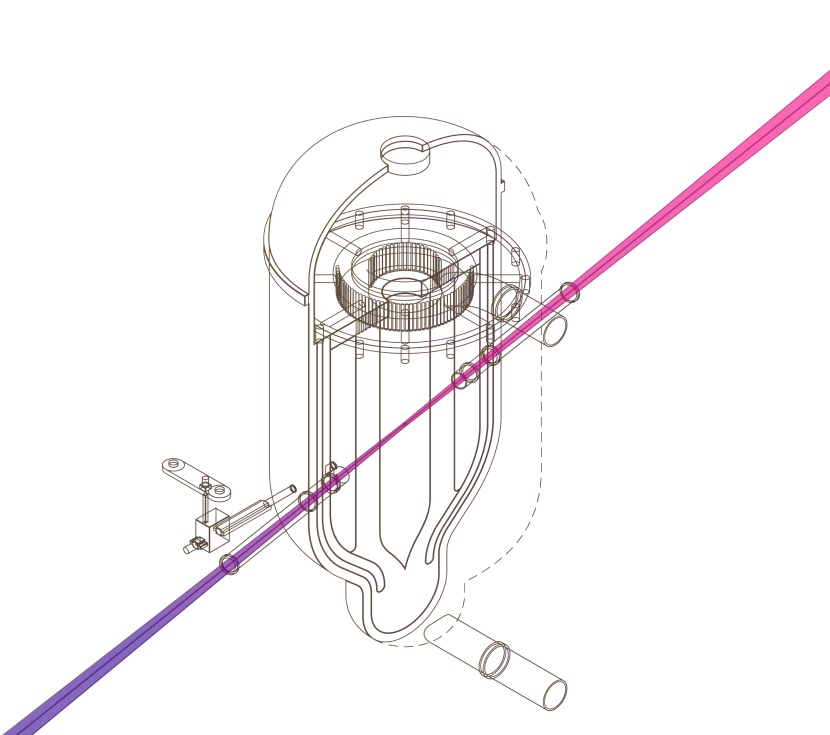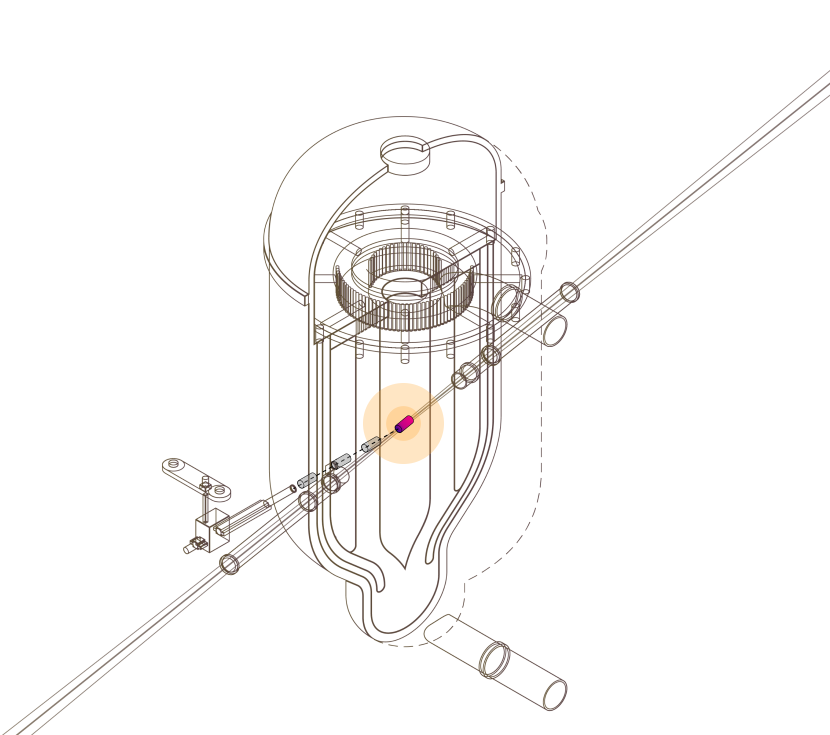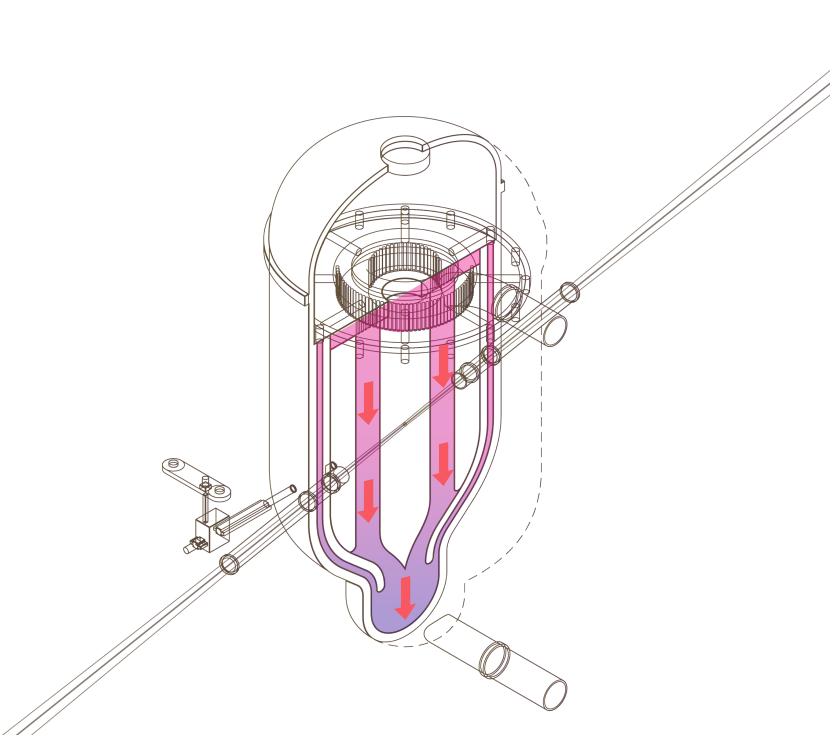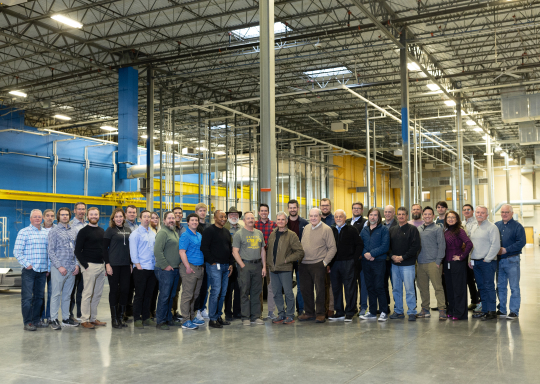We have the most viable path to commercializing the only experimentally demonstrated fusion technology.
Our low-cost, high-efficiency laser technology will allow us to build the world's largest laser and scale the successful breakeven demonstrations at the National Ignition Facility to commercial operation.
Our plan builds on decades of investment in gas excimer laser systems for semiconductor lithography and defense, combined with fuel capsule and power plant advances that have been waiting for a laser system to enable them.

We're overcoming the challenges that have blocked the commercial application of inertial fusion energy (IFE).
-
Lower Laser Cost
By using a gas laser architecture, we've reduced the cost per joule by more than 30x compared to the National Ignition Facility (NIF).
-
10+ MJ Laser
Our lower-cost design allows us to build a much higher-energy laser—with under 1 square meter of final optical area.
-
Larger Fuel Capsules
With more laser energy, we can ignite larger fuel capsules that are easier to produce, more robust, and capable of achieving higher fusion gain.
-
Lower Repetition Rates
Because of that higher gain, we can run at lower repetition rates (less than 1 Hz), which simplifies engineering and significantly reduces capsule fabrication costs.
-
Low-Maintenance Chamber
We use flowing liquid lithium salt to protect the chamber's structural walls from fusion neutrons—minimizing maintenance and reducing waste.
-
Superior Economics
Together, these advantages simplify the development roadmap and cost of a power plant, giving us the clearest, lowest-risk path to commercial fusion with the best long-term economics.
-
What other fusion approaches are there?
Fusion approaches can be generally classified by how long the fusion plasma is confined, and the method by which the fusion plasma is confined. Across approaches, confinement times range from 10s of picoseconds to several seconds, with plasma densities inversely correlated, ranging from 100s of grams per cc to billionths of a gram per cc. For the long confinement times and low densities, magnetic fields are used for plasma confinement, with the prototypical example being a tokamak. For the short confinement times and high densities, inertial confinement is used, with the prototypical example a laser to implode fuel capsules like on the NIF. There are several approaches in between at moderate confinement time and density, including using pulsed power to drive hybrid magnetic-inertial systems. At this time, the private sector is pursuing all of these differing approaches.
-
How does our approach compare to these other approaches?
To date, only the laser inertial approach using deuterium-tritium (DT) fuel has achieved fusion ignition and scientific breakeven. That’s the foundation we’re building on—but we’re pushing it further.
Our system architecture is uniquely decoupled. Our laser can stand off up to 50 meters from the low-mass fuel capsule and enter the reactor chamber through just two small openings. The fusion reaction takes place in about a cubic centimeter of space, isolated from the chamber’s first wall—there’s no physical connection.
This design lets us use molten salt coolant to fully protect the structural wall from fusion output. And with short confinement time and high fuel density, our targets undergo burn propagation—meaning that ignition of just a small amount of fusion fuel can trigger a chain reaction that ignites the rest, like lighting a match.
That leads to high wall-plug energy gains, even with a 5–10% efficient laser. When you combine all of these advantages, it’s clear: laser inertial fusion has the strongest long-term economic potential of any fusion power approach—and we’re building the system to deliver it.
10+ MJ Krypton Fluoride Laser
Our laser combines nonlinear "gas" optics with excimer laser amplifiers to produce very high beam energies at low cost. Excimer lasers have seen wide commercial application in semiconductor lithography, medical and industrial applications.

Fusion Fuel Capsule
Like NIF, our fuel capsules are consumables containing hydrogen (DT) fuel that are ignited by the laser, but at much larger size and mass, resulting in higher performance, easier manufacturing, and more robust operation. The higher performance means a power plant can operate at lower repetition rates (< 1 Hz) than conventional IFE concepts.

HYLIFE III FLiBe Chamber
Pioneered at Livermore National Lab and UC Berkeley over several decades, the chamber uses a self contained liquid flow of lithium salt, or FLiBe to absorb fusion output and completely protect the first structural wall.

We are building on over 100 years of science and decades of fusion development
The timeline presents pivotal milestones, tracing the journey of fusion energy from the early 20th century’s experiments and foundations, to the 2022 landmark of net energy gain at NIF. They mark key innovations, advancements and partnerships that led to the development of our IFE system.
In 1926 Arthur Eddington proposed that stars
produce energy from hydrogen fusion.
-
1939
Hans Bethe Develops Theory for the Sun’s Fusion Fuel Cycle
For over a century it was not known how the sun could maintain its temperature and energy output for the billions of years that geologists knew the earth had been in existence. In 1939, Hanz Bethe finally discovered the nuclear fusion cycle that powers the sun, which involves proton-proton fusion.
-
1952
Ivy Mike, First Fusion Test
Los Alamos Laboratory
The idea of using fusion in a weapon dates back as early as the Manhattan project, and was developed primarily by Edward Teller and Stanislaw Ulam. Their concept was to use the x-ray energy produced by an atomic fission device to flow over to a physically separate fusion component and implode and ignite this separate component. This worked on the very first try in the Ivy Mike test of 1952, which yielded 10 megatons of energy. The fusion plasma was inertially confined and produced enormous fusion gain. The physical principle of high-gain inertial confinement fusion was conclusively demonstrated here.
-
1958
Fusion Tokamak Began Operation
Kurchatov Institute in Moscow
Experimental results from the first Tokamak, the T1, were submitted to the second Atoms for Peace conference in Geneva in 1958. A Tokamak confines a plasma in a toroidal geometry, and, along with the Stellarator, is the most-studied magnetic fusion concept to date.
-
1960
Laser is Invented
Hughes Research Laboratory
Theodore Maiman operated the first laser on May 16th 1960 at Hughes Research Laboratory using flashlamps and a ruby rod. The initial paper was rejected by Physical Review Letters, but was subsequently published in Nature.
-
1962
Laser Inertial Fusion is Put Forward
Lawrence Livermore National Laboratory
Shortly after the laser was invented, scientists realized a laser could be used to provide the temperatures and pressures needed to implode and ignite fusion fuel, without needing an atomic fission bomb. The major difference, however, was that the laser energy available was many orders of magnitude less than what could be provided by a fission bomb, and this led to many challenges.
-
1968
1 keV Temperature Demonstrated on Tokamak
Kurchatov Institute in Moscow
The Russians announced the achievement of 1 keV electron temperature in the T3 tokamak in 1968. This result was met with intense skepticism, but was confirmed the following year by a team of physicists from the UK who visited the machine and performed their own measurements.
-
1972
John Nuckolls 1972 Paper
Lawrence Livermore National Laboratory
Nuckolls’ seminal paper in the field of inertial fusion proposed using a laser pulse shaped precisely in time to implode DT fuel and achieve densities 10,000 times solid. It was estimated that if this could be achieved, then ignition could be achieved with only 1 kJ of laser energy. While this turned out to be impossible due to hydrodynamic instabilities and nonlinear laser plasma interaction issues, it began investigation into laser-driven inertial fusion in earnest.
-
1975
HYLIFE-I Chamber is Proposed
Lawrence Livermore National Laboratory
The High Yield Lithium Injection Fusion Energy (HYLIFE) chamber was the first proposal put forward by Livermore for how to contain sequential fusion bursts and convert the energy into heat to drive a steam cycle. The concept utilized two opposing beams to illuminate a sequence of fusion targets at a repetition rate of once per second inside a waterfall of lithium contained in a steel chamber. The lithium would contain gigajoule fusion bursts and protect the steel chamber from all ions, target debris, and 14 MeV neutrons. Xcimer’s approach is largely based around this original concept.
-
1977
Shiva Laser Built at LLNL for Laser Fusion Research
Lawrence Livermore National Laboratory
The Shiva laser was a 10 kJ system at 1 micron wavelength. It was the largest laser in the world at the time, and was built to better understand the coupling of laser energy to a fusion target as well as target implosions. A major result was the discovery of the need to move to shorter wavelengths due to laser plasma interactions inhibiting effective coupling of laser energy to targets.
-
1970's
Various Excimer Lasers are Developed
The first excimer laser was built at Livermore by Paul Hoff in 1972, and by the late 70s many more excimers had been discovered, including argon fluoride and krypton fluoride. Much of the gas chemistry of these lasers had been worked out by the end of the decade, with several kJ-scale systems built.
-
1984
Nova laser completed
Lawrence Livermore National Laboratory
The Nova laser was built after lessons learned on Shiva, and could hit a target with a 45 kJ laser pulse at a much shorter wavelength of 351 nm. Ignition was expected, but it was more difficult to achieve the needed high-compression implosions than originally thought (the lower the laser energy, the higher the compression of the fuel capsule that is needed). Nevertheless, Nova significantly advanced the science of inertial fusion, and paved the way for the NIF.
-
1986
Halite Centurion tests demonstrate High-Gain Inertial Fusion
A series of underground nuclear tests were fielded to lay to rest the viability of imploding and igniting laboratory scale fusion fuel capsules. These capsules were driven by siphoning a very small amount of x-ray energy from adjacent nuclear detonations, and they achieved ignition and high gain. Detailed reports are classified, but these tests conclusively demonstrated inertial fusion energy is possible with a high-enough energy laser.
-
1986
NAS Review Recommendation to Build 10 MJ Laser
National Academy of Sciences
The National Academy of Sciences held a review of inertial fusion in 1986, after analysis of all data to date from both laser fusion facilities as well as the Halite Centurion tests. The committee recommended the construction of a 10 MJ laser to ensure robust fusion ignition and high gain.
-
1995
National Ignition Facility Project Starts
Lawrence Livermore National Laboratory
The National Ignition Facility was sold to Congress with a laser energy of 2 MJ, significantly short of the 10 MJ level recommended by the NAS. The 2 MJ system was a compromise, as a 10 MJ system with then-proposed technologies would have been far too expensive.
-
1997
JET Tokamak Gets Close to Breakeven
Culham Centre UK
The Joint European Torus set a world record in fusion plasma power gain of 0.67, producing 16 MW of peak fusion power with 24 MW of heat deposited into the plasma during a pulse of a couple seconds. While this gain is measured relative to fusion peak power, a value of 1 is defined as scientific breakeven for a tokamak. Thus the JET experiments have produced the highest performing fusion plasmas to date, after the NIF.
-
2010
Efficient, repetitively pulsed excimer laser for IFE demonstrated
NRL
During the High Average Power Laser (HAPL) program, the Naval Research Laboratory (NRL) significantly advanced excimer laser technology for inertial fusion energy. In particular, the kJ-scale Electra laser operated repetitively at five shots per second for up to a day at a time, demonstrating key technology necessary for enabling an excimer laser to continuously shoot fusion fuel capsules in a power plant.
-
2022
Breakeven Achieved at the NIF
Lawrence Livermore National Laboratory
In 2022 the NIF achieved scientific breakeven, with the fusion burst from a fusion target exceeding the total laser energy delivered to the target. Since then, the NIF has improved over this result, with 5 MJ of fusion energy produced from a 2 MJ laser pulse. The significance of this result is the production of a fully ignited and burning plasma, with a fuel capsule gain of 20. The data from the NIF fully supports the original 1986 NAS conclusion that a 10 MJ would allow for robust ignition and high gain.
-
XEC Locations
-
Partner Locations

